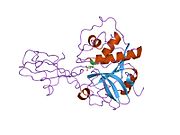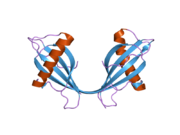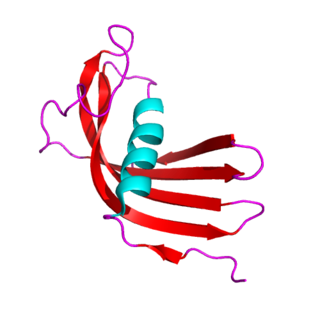
The cystatins are a family of cysteine protease inhibitors which share a sequence homology and a common tertiary structure of an alpha helix lying on top of an anti-parallel beta sheet. The family is subdivided as described below.
Unverricht–Lundborg disease is the most common form of an uncommon group of genetic epilepsy disorders called the progressive myoclonus epilepsies. It is caused due to a mutation in the cystatin B gene (CSTB). The disease is named after Heinrich Unverricht, who first described it in 1891, and Herman Bernhard Lundborg, who researched it in greater detail in 1901 and 1903. ULD onsets in children between the ages of 6 and 16; there are no known cases in which the person was older than 18. Most cases originate from the Baltic region of Europe, though many have been reported from countries in the Mediterranean.

Cathepsin B belongs to a family of lysosomal cysteine proteases known as the cysteine cathepsins and plays an important role in intracellular proteolysis. In humans, cathepsin B is encoded by the CTSB gene. Cathepsin B is upregulated in certain cancers, in pre-malignant lesions, and in various other pathological conditions.
Progressive Myoclonic Epilepsies (PME) are a rare group of inherited neurodegenerative diseases characterized by myoclonus, resistance to treatment, and neurological deterioration. The cause of PME depends largely on the type of PME. Most PMEs are caused by autosomal dominant or recessive and mitochondrial mutations. The location of the mutation also affects the inheritance and treatment of PME. Diagnosing PME is difficult due to their genetic heterogeneity and the lack of a genetic mutation identified in some patients. The prognosis depends largely on the worsening symptoms and failure to respond to treatment. There is no current cure for PME and treatment focuses on managing myoclonus and seizures through antiepileptic medication (AED).

Cathepsin L1 is a protein that in humans is encoded by the CTSL1 gene. The protein is a cysteine cathepsin, a lysosomal cysteine protease that plays a major role in intracellular protein catabolism.
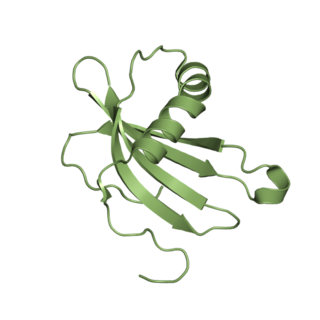
Cystatin-A is a protein that in humans is encoded by the CSTA gene.

Cathepsin H is a protein that in humans is encoded by the CTSH gene.

Cystatin-S is a protein that in humans is encoded by the CST4 gene.
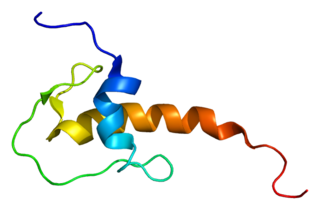
Lympho-epithelial Kazal-type-related inhibitor (LEKTI) also known as serine protease inhibitor Kazal-type 5 (SPINK5) is a protein that in humans is encoded by the SPINK5 gene.

Cystatin-SN is a protein that in humans is encoded by the CST1 gene.

Cystatin-SA is a protein that in humans is encoded by the CST2 gene.

Cystatin-M is a protein that in humans is encoded by the CST6 gene.

Cystatin-F is a protein that in humans is encoded by the CST7 gene.
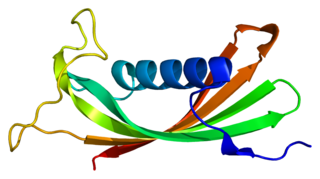
Cystatin-D is a protein that in humans is encoded by the CST5 gene.

Cathepsin L2 is a protein encoded in humans by the CTSV gene.

Cystatin-8 is a protein that in humans is encoded by the CST8 gene.

Cathepsin W is a protein that in humans is encoded by the CTSW gene.

Cathepsin F is a protein that in humans is encoded by the CTSF gene.

Cystatin-9-like is a protein that in humans is encoded by the CST9L gene.

Cystatin-11 is a protein that in humans is encoded by the CST11 gene.



















